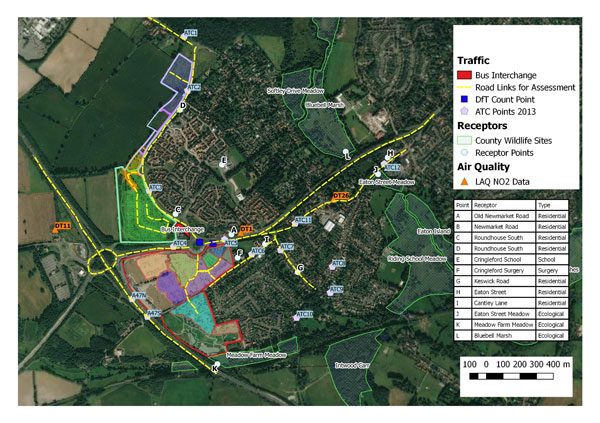
AQIA, Cringleford, Norwich
LOCATION: Cringleford, Norwich
PROJECT TYPE: Air Quality Impact Assessment
VALUE: £10K
BACKGROUND
As part of the planning requirements for two proposed residential developments (650 houses over 6 phases) in Cringleford, Norfolk, Harrison Group was commissioned to carry out an Air Quality Impact Assessment (AQIA) on behalf of Kier Living and Big Sky.
The potential impacts from air emissions and dispersion of pollutants from traffic flows and construction were modelled and compared with relevant legislation, planning policies and Regulatory Air Quality Standards (AQS) and Objectives for the local area.
SCOPE OF WORK
The AQIA was completed in accordance with the latest Institute for Air Quality Management (IAQM) and Defra guidance.
Levels in air of NO2 and Paticlate Matter M10 from road traffic were derived using the Atmosheric Dispersion Modelling System-Roads version 5 emission and atmospheric dispersion model based on traffic density, type and average speeds, source emissions factors, meteorological data, road layout, and location of sensitive receptors.
Impact was assessed based on modelled changes in local air quality and comparison with AQS and Objectives at sensitive receptor locations, and cumulative effects from other planned or proposed developments in the local area.
Emissions were calculated using the latest emissions factors from Defra, based on the 2013 and 2026 emission factors respectively within the Emission Factor Toolkit v8.0 incorporated into ADMS-Roads.
Model verification was completed based on the South Norfolk District Council diffusion tube monitoring data and available co-located traffic data at the following locations.
OUTCOME
All work was carried out to the satisfaction of the client.
- Contour plots showing the ground level concentrations of NO2 for the 2021 With Development and Committed Development scenario were derived
- All modelled levels at sensitive receptor points were shown to be less than 75% of AQS with less than 2% change relative to AQS compared with baseline levels
- As per the Institute of IAQM Guidelines the development effects were assessed as having a negligible impact on air quality.


